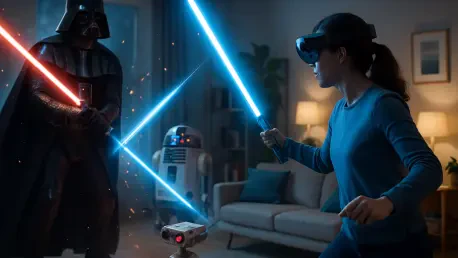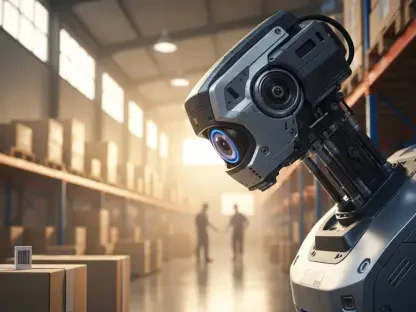In a galaxy not so far away, a new frontier in gaming has emerged with the release of Star Wars: Beyond Victory – A Mixed Reality Playset on Meta Quest 3 and 3S platforms, challenging the boundaries of how immersive experiences are crafted and pushing the limits of technology. Priced at an accessible $19.99, this collaboration between Industrial Light & Magic (ILM) and Lucasfilm plunges players into the high-stakes world of podracing during the Reign of the Empire era, a timeline echoing the gritty undertones of Solo: A Star Wars Story. By blending augmented reality (AR) and virtual reality (VR), the game promises to unite generations of Star Wars fans through a pioneering mixed reality (MR) format, raising a pivotal question about its potential to transform the gaming landscape. As ILM ventures beyond their VR successes like Vader: Immortal, this title steps into experimental territory, aiming to merge real-world spaces with iconic Star Wars narratives. Early feedback highlights a mix of innovation and hurdles, suggesting that while ambition drives this project, execution may determine its lasting impact. This exploration seeks to uncover whether Beyond Victory can carve a new path for mixed reality gaming or if it merely teases what’s possible on the horizon.
Pushing Boundaries with Mixed Reality Innovation
The core of Star Wars: Beyond Victory lies in its daring fusion of AR and VR, crafting an experience that diverges sharply from ILM’s prior fully VR endeavors. Players can toggle between AR for expansive exploration—interacting with a tabletop-style Star Wars universe overlaid on their real environment—and VR for pivotal story sequences, creating a dynamic interplay between two realities. This hybrid model offers a glimpse into how mixed reality could redefine interactive storytelling by allowing physical spaces to become part of the game world. Executive Producer Alyssa Finley has emphasized the intent to make this an inclusive journey for both seasoned fans and newcomers, a goal reflected in the game’s modest price point. Yet, initial reviews point to a fragmented feel, where switching between modes can disrupt narrative flow. This raises a critical consideration: while the concept is groundbreaking, does the technology fully support the vision, or does it risk alienating players accustomed to more seamless experiences?
Beyond the technical framework, the game’s structure with three distinct modes—Adventure, Arcade, and Playset—demonstrates an intent to cater to diverse playstyles, from story-focused quests to creative freedom. Adventure Mode serves as the narrative backbone, while Arcade offers competitive racing challenges, and Playset provides a sandbox for custom Star Wars scenes. Such versatility hints at mixed reality’s potential to expand gaming beyond traditional formats, possibly inspiring developers to explore multifaceted designs. However, feedback suggests that the execution of these modes varies, with some lacking depth or polish. If mixed reality is to set a new standard, it must balance innovation with consistency. Could this experimental approach by ILM spark a wave of creative risk-taking in the industry, or does it reveal the growing pains of an emerging technology still finding its footing?
Crafting Stories in a Podracing Underworld
At the heart of Star Wars: Beyond Victory is a narrative that dives into the seedy underworld of podracing, casting players as Volo Bolus, an aspiring racer on the planet Malastare, mentored by the notorious Sebulba from The Phantom Menace. The Adventure Mode, clocking in at roughly two hours, weaves an emotionally charged tale centered on Volo’s quest to honor a lost friend, Pyya, with voice performances that add depth to even the briefest interactions. Connections to broader Star Wars lore, including characters like Grakkus the Hutt and subtle nods to franchise history, enrich the experience, showcasing how mixed reality can deliver stories with personal stakes amid a familiar galaxy. This suggests a powerful avenue for MR to enhance narrative engagement, blending emotional resonance with iconic settings in ways traditional platforms might struggle to match. Does this storytelling approach signal a new era for immersive narratives?
Yet, the story’s brevity and limited focus on actual podracing—featuring just two races alongside minimal driving sequences—temper enthusiasm for its potential. Despite the inclusion of intricate world-building elements like in-game radio commentary and hidden Easter eggs, the narrative feels more like a preview of a grander epic than a fully realized journey. For mixed reality to redefine gaming, sustained player investment through deeper content seems essential. Reviews reflect a longing for expanded story arcs and more racing action, pointing to a gap between ambition and delivery. If narratives in MR are to captivate long-term, must developers prioritize length and variety over concise emotional beats, or can shorter, impactful tales like this still carve a niche in the evolving gaming sphere?
Navigating Gameplay in a Dual-Reality Format
Gameplay in Star Wars: Beyond Victory hinges on its mixed reality design, where AR dominates with a top-down perspective for races and exploration, while VR anchors critical story moments and hands-on tasks like podracer maintenance. This setup aims to innovate player interaction by embedding Star Wars environments into real-world spaces, offering a novel way to engage with the franchise. However, reviews highlight immersion challenges, such as the jarring shift when players glance away from the virtual overlay to their actual surroundings, breaking the spell of the game. The intent to blend realities is clear, but the execution sometimes undermines the fantasy, prompting reflection on whether mixed reality can truly enhance gaming experiences or if it introduces distractions that conventional formats avoid. Is this dual approach a step forward, or does it reveal limitations in current technology?
Adding to gameplay concerns is the absence of first-person VR control during podracing sequences, a feature many anticipated given the theme. Instead, races unfold from an AR overhead view, capturing the high-speed decision-making of The Phantom Menace but missing the visceral thrill of direct piloting. While the speed and challenge of these segments earn praise, the disjointed integration of AR and VR components leaves a sense of fragmentation. For mixed reality to redefine gaming standards, seamless transitions and player agency appear crucial. Feedback suggests that future iterations might benefit from prioritizing one reality over splitting focus. Could refining this balance unlock the full potential of MR gameplay, or does the current model hint at inherent constraints that developers must navigate in this evolving field?
Expanding Horizons with Additional Features
Beyond its core narrative, Star Wars: Beyond Victory offers Arcade and Playset Modes to bolster replay value and showcase mixed reality’s versatility. Arcade Mode lets players revisit racing and driving challenges in a holotable-style arena, aiming for high scores and unlocking unique podracers with distinct stats. This competitive edge hints at how MR can adapt traditional gaming elements like leaderboards into innovative formats, potentially inspiring future titles to blend nostalgia with cutting-edge tech. However, the mode’s limited content—lacking new tracks or substantial additions beyond the main story—curbs its long-term appeal. Reviews note that while it provides a fun distraction, it falls short of the depth seen in classic podracing games. Does this suggest that mixed reality can enhance replayability, or must it offer more robust content to keep players engaged over time?
Playset Mode, meanwhile, transforms mixed reality into a creative outlet, allowing players to pose digital Star Wars figures and vehicles within their real environment, akin to a virtual diorama. Originally a tool for ILM’s film production, this mode aims to tap into imaginative play but struggles with clunky controls and limited appeal, as early feedback indicates minimal sustained interest. Compared to similar features in other games, it feels underwhelming, especially as much of the game’s unlockable content ties to these lackluster rewards. For mixed reality to redefine gaming, such features must offer meaningful engagement rather than serving as mere novelties. Could future updates refine these extras into compelling additions, or do they underscore a need for mixed reality to focus on core experiences before branching into ancillary modes?
Reflecting on a Bold Step Forward
Looking back, Star Wars: Beyond Victory stood as a courageous experiment in mixed reality gaming, blending AR and VR to deliver a podracing tale that resonated emotionally with Star Wars fans despite its compact scope. Its accessible price and innovative design captured attention, even as immersion issues and limited content tempered broader acclaim. The game’s mixed reception highlighted both the promise and pitfalls of pushing technological boundaries, offering a snapshot of an industry in transition. ILM’s effort carved a notable entry in their portfolio, proving that even imperfect steps could illuminate paths for others to follow.
Moving ahead, the journey of mixed reality gaming seems poised for growth, with lessons from this title paving the way for refinement. Developers might consider prioritizing seamless integration of AR and VR to enhance immersion, while expanding narrative and gameplay depth to sustain player interest. Exploring updates or expansions for Beyond Victory—such as additional races or deeper story arcs—could address past critiques, setting a precedent for iterative improvement in MR titles. As technology advances, the industry should focus on balancing innovation with substance, ensuring that future games build on this foundation to deliver truly transformative experiences. The potential remains vast, and with careful strides, mixed reality could indeed redefine how stories and games intertwine in the years to come.









